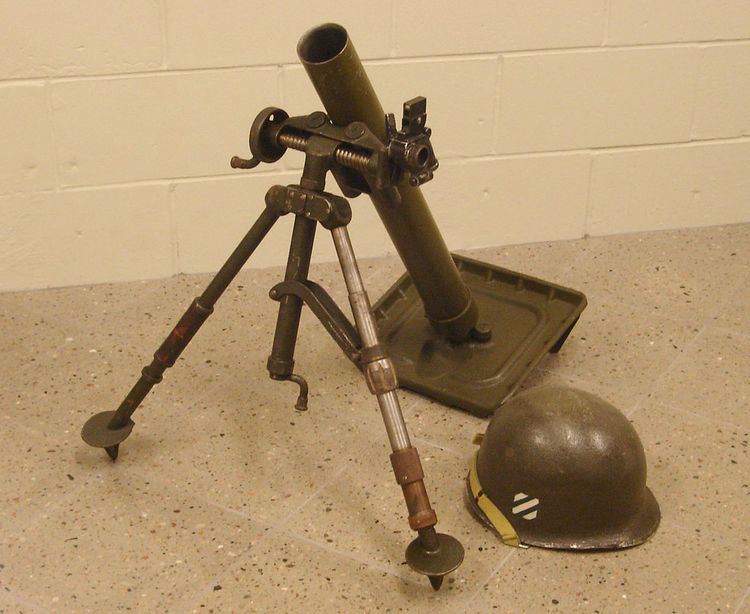Weight 19.05 kg (42 lb) | Place of origin USA Variants Type 31 | |
 | ||
Wars | ||
The M2 Mortar is a 60 milimeter smoothbore, muzzle-loading, high-angle-of-fire weapon used by U.S. forces in World War II, the Korean War, and the Vietnam War for light infantry support.
Contents
Description
The U.S. M2 60 mm mortar was developed from the heavier 81 mm M1 Mortar to provide a lighter-weight alternative to company-level fire support. The M2 attempted to bridge the gap between the 81 mm mortar and the hand grenade. Normally employed by the weapons platoon of a U.S. infantry company, the M2 is of the usual mortar pattern of the day. It consists of a smoothbore metal tube on a rectangular baseplate, supported by a simple bipod with the elevation and traverse mechanisms. The firing pin was fixed in the base cap of the tube, and the bomb was fired automatically when it dropped down the barrel. Though classed as a light mortar, the M2 had considerable range compared to the 50 mm and 60 mm mortars of most other nations, and its fixed-firing pin design allowed a high rate of fire by trained crews.
History
During the late 1920s, the US Army began examining mortars to act as a light infantry support weapon. The War Department eventually settled on a 60 mm design from Edgar Brandt, a French ordnance engineer, and purchased a license to build the weapon. The model was standardized as the Mortar, 60 mm M2. Testing took place in the late 1930s, and the first order for 1,500 M2 mortars was placed in January 1940.
The weapon was used throughout World War II by the U.S. Army and U.S. Marine Corps. It saw service again in the Korean War, and by French forces in counterinsurgency campaigns in Indochina and Algeria. During the Vietnam War, the M2 was again used by the U.S. Army and Marines, as well as by South Vietnamese forces. Ultimately, the M2 was replaced by the M224 in 1978.
China (the Republic of China, prior to 1949) also locally produced the M2 mortar, which was designated as the Type 31.
Operation
Each mortar shell had a screw-on cap in its base. Inside the hollow in the tail, it contained a 20-gauge M5A1 Ignition Cartridge. This was a paper shotgun shell filled with ballistite powder.
The mortar had a firing pin in the bottom of the tube. When the shell was dropped down the tube, the firing pin struck the Ignition Cartridge in the shell's tail, detonating it. When the cartridge detonated, the explosive gases exited the base of the shell through two bleed holes. This propelled the shell out of the tube in an arc. Unassisted, the mortar shell had a range of about 200 to 325 yards.
To increase the mortar's range, bags of booster charges were fastened to the tailfins with clips. Up to four bags could be fitted to the shell's tail, extending the maximum range to about 2,000 yards (depending on the shell's length and weight).
Ammunition
The M2 Mortar could fire several types of ammunition.
Unlike regular smoke shells of the period, which used a "hot" chemical reaction to generate a smoke cloud, the white phosphorus shell detonates to expose its filler to the air, causing it to spontaneously ignite and generate a thick cloud of white or grey smoke. It also sets combustible materials in its radius of effect on fire, causing secondary smoke sources. If personnel are hit by burning white phosphorus, the fragments will continue to burn inside the wound. They need to be evacuated to a hospital to have the fragments removed under special conditions.
